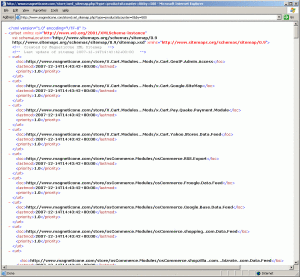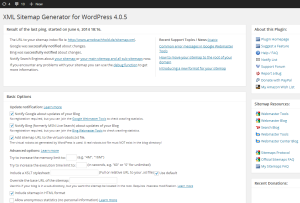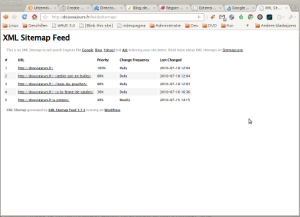
What is a Sitemap?
The XML Sitemap & Google News feeds plugin is simple yet powerful. In adition to updating your sitemap, it will also update the robots.txt file to let search engines know where to find the updated sitemap.
Sitemaps is a technology which allows you to keep search engines informed of the changes and additions to your website, as well as which pages are available for crawling. Originally developed by Google, Sitemaps has been released into the public domain and has now been adopted by Bing.
Traditionally a site map is a page on your website which lists all the major pages of your website, with links directly to those pages.
This is not what we are talking about here. A Sitemap is an XML file which lists all the pages on your site which are available for crawling along with the last time they were updated, how often they are likely to change and their relative importance. It can get a little bit more complicated than that as you can have multiple sitemaps which cover different sections of your website. This is particularly useful for larger websites.
Simple plugin that generates a sitemap for your site and submits it to search engines every time it’s updated.
This plugin is full of features and has over 1 million active installs. If you’re looking for some extra features from your sitemap plugin then Google XML Sitemaps is the plugin for you.
XML Sitemap & Google News feeds
Why use a sitemap
A Sitemap is a great way to inform a search engine of your website and in my experience, both Yahoo! and Google index my websites much quicker if I supply a sitemap. They are also great to use when you make a large number of changes. If your site updates frequently, it is going to be a good idea to have your sitemap automatically generated.
An example of a simple Sitemap
<?xml version="1.0" encoding="UTF-8"?>
<urlset xmlns="http://www.sitemaps.org/schemas/sitemap/0.9">
<url>
<loc>http://wpshowdown.com/</loc>
<lastmod>2007-02-01</lastmod>
<changefreq>weekly</changefreq>
<priority>1.0</priority>
</url>
<url>
<loc>http://wpshowdown.com/</loc>
<lastmod>2007-02-01</lastmod>
<changefreq>daily</changefreq>
<priority>0.8</priority>
</url>
</urlset>
The Sitemap explained
A sitemap can be created in a simple text file, but it will probably be easier to use a tool.
I will briefly explain what each of the elements in the sitemap are and how they are used. For a more detailed explanation, see www.sitemaps.org
- urlset – This is the main element (tag if you’re used to HTML) and must surround all other elements in the Sitemap. You’ll see in the above example that except for the <?xml bit, the file begins and ends with the urlset tag.
- url – This element is used to group the information for each of the pages in your website. All page information will go inside of the url tag. In the example above, you’ll see that there are two urls being described.
- loc – This is the actual URL of the page. You need to enter the entire url as you would put it into the browser, including the http://. The easiest way to do this is just to copy the url out of the browser address bar.
All the elements above must be in the sitemap. The other elements described below are optional and you only need to include them if they are relevant to your website.
- lastmod (optional) – This is the date that the page was last updated. The date must be in the format yyyy-MM-dd as in the example above (1 February 2007 as 2007-02-01).
- changefreq (optional) – This is an indication of how often the page will change. You can use one of the following values [always, hourly, daily, weekly, monthly, yearly, never]. If you’re not sure how often it will change, you should probably just leave this element out entirely.
- priority (optional) – This is a fraction from 0.0 to 1.0 which is an indication of the pages importants relative to all the other pages on this website. This does not affect how your pages are compared to pages on other websites, so setting everything to 1.0 is not going to help you in any way. If you leave this element out, the default value of 0.5 is used.
Note: A Sitemap is an XML file and needs to conform to XML standards. For simple pages, everything should work fine, but if you have special characters, including ‘&’, you will need to deal with those appropriately, unfortunately that is beyond the scope of this post. Some information can be found at www.sitemaps.org
Not a miracle answer to getting your website into search engines
While Sitemaps are useful, they are not a guarantee that you will be included into a search engine’s index. They are more like a hint of what’s out there. The individual search engines will still use their own rules to decide if, when or how they will include you in their indexes.
All the information in the Sitemap other than the url is treated as a hint used to optimise how or when the search engine visits your website. Each search engine could use this information differently.
How to submit my sitemap



